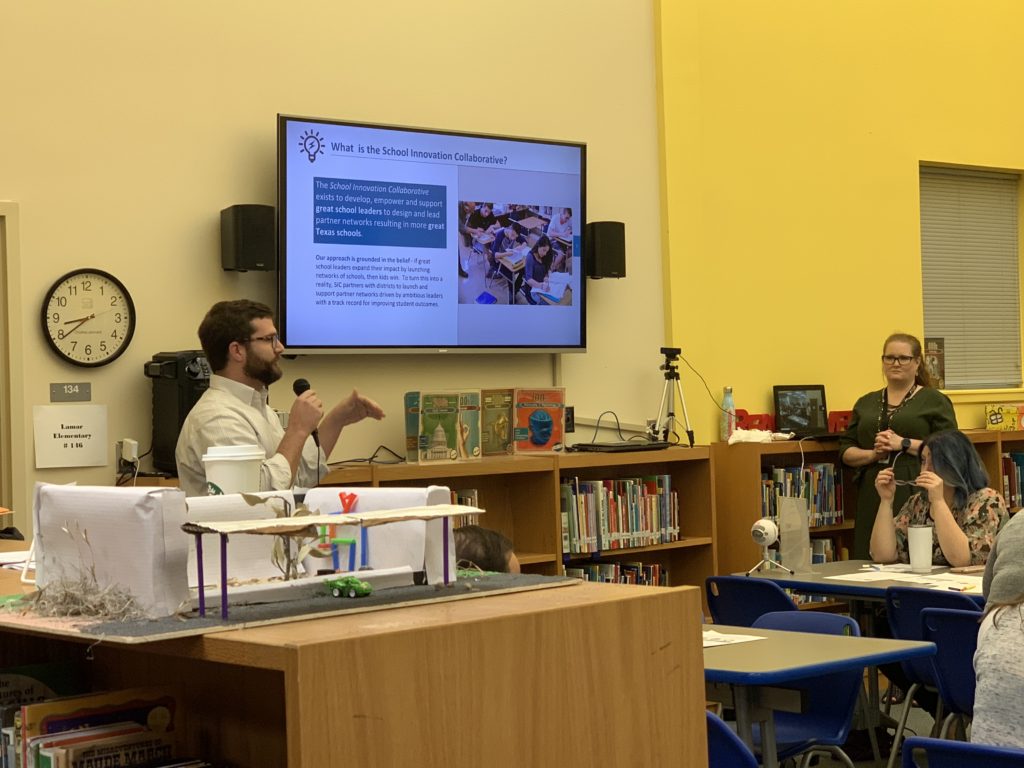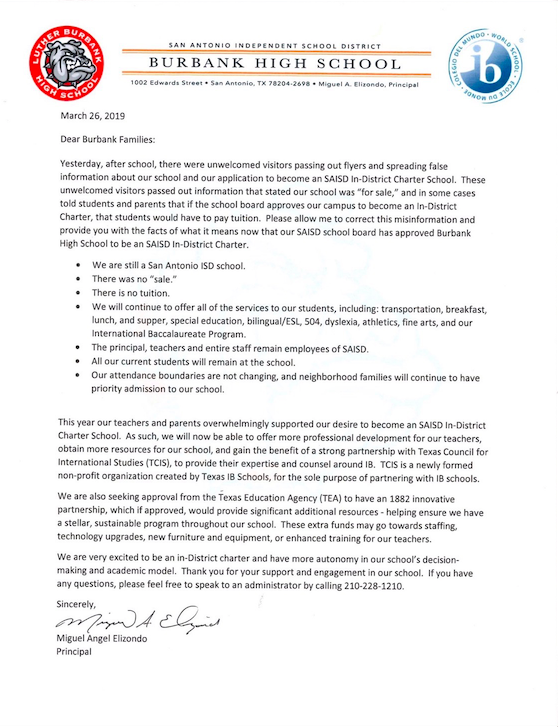Meet Doug Dawson, the guy you should have already met.

Doug Dawson does not sound, look, or act like the kind of guy who might wake up to find himself at the center of conspiracy theories and public outrage. But that’s what happened on March 26, after it was announced that the Teach for America alum and former Texas Education Agency bureaucrat would be heading the School Innovation Collaborative.
The soft-spoken Dawson thought he was coming to town to act as belay for principals Brian Sparks and Sonya Mora as they broke free (with the district’s blessing) from the administrative tether of San Antonio ISD, and began pressing upward with student outcomes at Gates Elementary, Cameron Elementary, Lamar Elementary, and Bowden Elementary. What he ended up doing was meeting with individual teachers and parent groups to try to soothe the SNAFU that was the rollout of the latest “1882 partnerships” (my assessment, not his).
The substance of the partnership with Dawson and the School Innovation Collaborative is pretty mundane, and, having read it myself in its entirety, helpful.
Gates and Bowden have applied for in-district charters, and Lamar already has one. The charters grant certain autonomies from district budgets, calendars, staffing oversight, and curriculum.
With great freedom, of course, comes great administrative overload. Sparks and Mora are both network principals—they oversee two campuses. They already have limited time, which has ruffled feathers of those who have enjoyed their substantial and undivided attention. Taking on the administrative elements of the charter could have chained the leaders to their desks, or worse, obligated them to constant meetings with SAISD central administration.
“Sometimes you need almost like a sherpa to help,” Dawson said, choosing a different mountain-based metaphor for the relationship. His main role is to keep track of progress, and take all those meetings at central office. He’s supposed to do whatever needs to be done to maximize the time Sparks and Mora spend on their campuses.
However, speculation erupted that Dawson was to act less as sherpa, and more as expedition leader, taking the schools out of the district and toward privatization.
Dawson would be an odd choice for such a maneuver. He’s never really operated in the private sector, after a brief stint in accounting right out of college. He was a middle school math teacher in Dallas, where he realized he had a lot to learn if he wanted to be successful with all students.
“That experience gave me a lot of humility around how hard it is to be an educator,” Dawson said. He went on to Rice University’s education entrepreneurship program (REEP), where he honed his instinct that when it comes to what happens in the classroom, teachers should be “at the top of the decision making process” he explained. Every move up the chain should be about accountability and support…not control.
From there Dawson worked for YES Prep in Houston, and went on to the TEA where he helped 20 schools establish partnerships similar to the one he’s now part of with SAISD.
Dawson said he liked the community-driven partnerships best. That’s what drew him to Sparks and Mora. Their methods were not based on specific, alternative models like single-gender education or International Baccalaureate. They were derived from the assets and needs of staff, students, and community. For some schools a program like International Baccalaureate or Dual Language is the way to go, he said, “You as a district and a campus need to figure out if that tool is best for your campus.”
For those who chose a more purist path, there are plenty of existing nonprofits able to facilitate the professional development, curriculum acquisition and training, and fundraising necessary to make the model work on their partner campus.
Such a partnership did not exist for Lamar or Gates.
Sparks testified to both the SAISD board and a library full of frustrated parents that he had looked high and low for other partners. None had fit the model and methods the community had chosen in their charter. Mora was in the same situation.
Some have suggested that the logical thing to do here would be to press on without a partner. However, Sparks gave two reasons he needed a partner: 1) the extra funds available to such partnerships under SB 1882 would bring more money from the state, which would allow him to do more within the charter, to execute it at a higher level. 2) If Sparks were to leave tomorrow, much of the work would go with him. The charters are like constitutions, but a lot depends on who sits in the principal’s office (think White House). Some campuses have seen their charters all but disregarded. Having a nonprofit committed to the charter is intended to guard against that. If the community of parents and teachers want to change their charter when it is up for renewal (or before), they could chose a more ideally suited partner. Or they could ask their partner to change with them. For Dawson, the specifics of the charter aren’t the main thing—the freedom and flexibility of leaders is his thing.
Dawson formed the nonprofit with Sparks and Mora in mind.
“I only wanted to find a situation in which I was able to create a structure where leaders were going to be given full autonomy and empowerment,” Dawson said. He is ready to work with the community, and has already started meeting with teachers and parents.
So, hearing and knowing all of that…why would anyone object to the partnership?
Because people didn’t hear about it or know about it until way too late in the game, that’s why. There’s a lot of finger pointing about whose job it is to get the word out on this stuff. Is it Superintendent Pedro Martinez? Is it the family engagement specialists? The communication department? The board? The office of innovation?
The response I’ve heard from parents: any and all of the above. If it’s not currently in someone’s job description, put it there.
In the void where outreach efforts should have been, conspiracy theories gave way to outright lies and scare tactics. Privatization is a scary word that was used to its full power: tuition, the end of free breakfast and lunch, private companies profiting off of public school children.

Parents were alarmed. The bungling cost campus leaders some of their parent allies, a handful of whom are about one maneuver short of staging a coup. Not only did principals take up the mantle of appeasing a miffed board on the night the management contracts were up for a vote, but they then spent the next week quelling rumors and misinformation among parents and teachers. Welcome to autonomy, I guess?
District administrators will get to continue on doing what they do, as long as they have the support of the board, which they likely will. The board understands the vision of the administration, and the methods of getting there. They have access to any administrator they want when they have questions. And they do ask questions. The board is on board.
But if the administration doesn’t get the community on board, it will continue fueling the campaigns of board challengers in upcoming elections. Christina Martinez and Patti Radle should be cruising to re-election on the merits of their voting records and work in the community. But the vote on the management agreements made them look like reluctant rubber stampers instead of the thoughtful, values-driven women they are.
When Christina Martinez said to Pedro Martinez and his team, “Please don’t put me in this position again,” she would have been well within her rights to say, “OR ELSE.”
The whole board should demand better community engagement from the administration. They look like they are giving away trust to an administration that can’t be bothered to explain why its plans are so trustworthy.
I say this as someone who does have reason to express confidence in the intentions and know-how of the administration. Someone who has more exposure to their plans than the average community member. It’s my job to understand what’s happening in the district and try to explain it, fairly and plainly. In that process I’ve gotten to know the players, gotten a lot of information on background, and wrapped my head around a story that the administration has yet to own.
So if you want to talk about the substance of the district’s reforms, I can give you my honest assessment of “is this a good thing?”
But that information and assessment would be way better coming from PTA presidents, beloved teachers, parent-family liaisons, and elected board members.
I’m also seeing something else happen. Something not in the plans. As a journalist, I’m not just watching the board book. I listen to the citizens to be heard, not once, but over time. I’m watching faces. I’m fielding panicked phone calls, and bumping into concerned citizens at the Y.
Watching Dawson, Sparks, and trustee Steve Lecholop address the Lamar PTA, they had to field a logical question: why did the partnership need to be rushed? Couldn’t the community have time to learn more?
They gave an answer that has gotten pretty stale in recent years: we were up against the State’s deadline. Not enough was official or in writing in the months leading up, when a public information campaign would have been ideal.
A reasonable request from confused parents trying to give their beloved principal the benefit of the doubt: Can’t it be walked back and delayed a year?
It fell to Lecholop to explain that the train had left the station, but that everything would be fine. Essentially he had to say, “Trust me.”
I heard the emotional cash-register in the background. Withdrawing from the same account that funded Austin, Stewart, Ogden, and Storm. If trust was a dollar, SAISD’s administration is spending freely while their opponents are doing their best to devalue it.
Looking at the faces in the room, I had to wonder if SAISD is going to keep getting more State money and resources for students, but go bankrupt on community trust in the process. Which made me wonder if they’ve figured out how key that asset is in the long-term success of their reforms.
And if they haven’t figured that out, I wonder if folks like Doug Dawson knew what they were getting into.